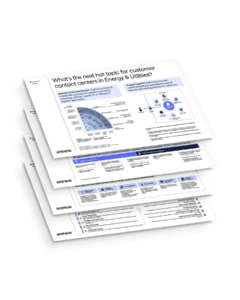Most businesses are project-centric. And there’s nothing wrong with that. When you’re building applications, changing the way you work, and transforming how you use data, a focus on project execution is a great benefit. It brings together the best mix of people and resources, in the right way to get the job done. But what happens after the deadline’s hit, the champagne’s been enjoyed, and the team packs away its laptops? Too often, the benefits of a project wither over time, as new methods and a fast-changing tech stack erode its advantages. It becomes less usable, less efficient, and eventually obsolete. In the worst case, it becomes legacy tech in just a few years, needing oversized investment to fix things later on. It’s impossible to define an architecture once and expect it to last forever – but that’s just what happens in a variety of businesses. That’s why many organizations are going product-centric.
They don’t lose focus on getting projects done – of course – but they do adjust priorities. They think critically about the capability the project produced, and what its future needs will be to keep ROI positive. They don’t create-and-forget, but keep adapting and improving over time to keep the value flowing.
Think about it. Is your market position really due to technology stacks, data models, and implementation cycles – the language of project management? Or is it about things that deliver value to customers: how you take orders, offer service, enrich people’s lives?
That’s the product-centric approach. Not defined start and end dates, but ownership and management of a product that creates value for your customers. (Whatever that product is.) It means each project is seen in context with the needs of the business, stays optimized and up-to-date over time, and is always ready for the next improvement opportunity. And obviously, it doesn’t end when the initial project does.
We’re big on product centricity at Eraneos. But we’re also passionate about bringing project centricity to our clients – and demonstrating how it keeps processes streamlined and integrated and the product performing over its entire lifecycle, whether that’s three months or ten years.
Here’s how we approach it – with examples from Hauke Meyer, a Senior Consultant and one of our experienced Agile/ Product Coaches at Eraneos, who interviewed and gathered experience from clients across the finance sector.First, let’s look at the typical drivers of a product-centric model. It’s a major change from traditional KPIs – but as you’ll see, it’s all for good reasons.
Raising expectations: the demanding internal client
Perhaps there was a time when the job of a software developer was to check every box on the scope and nothing more. But that’s long gone. Today’s internal clients – the people and departments who’ll use the product – are frequently tech-savvy themselves, and expect the product not just to work, but to work brilliantly.
These expectations are being driven by tech’s role as the key factor in business advantage; how you use technology arguably defines your position in the market. (Dr Mik Kersten, author of the book “Project to Product”, suggests half the S&P 500 will be replaced by tech firms by 2028.)
When quizzed on how to answer these expectations, one client – who, as P2P Program Manager, had seen successes from the approach before – stressed the importance of horizontal connections across the business. His first act when moving from project to product was to build an alliance with a key manager on the business side. Together they organized workshops and coaching sessions with the management team to build understanding, with Agile practices a big part.
His takeout: product centricity can answer these rising expectations – if both technology and business teams work together. So that’s our starting point.
1. AI systems that fall into 8 specific application areas:
“In a product-centric world, developers stay with their creations for the long term, with a sense of pride and ownership in making that product the best it can be. Such close attention means the product stays current and relevant for a lot longer – with the bonus that happier staff stay around longer, too.”
The war for talent: retaining top people
A second driver: as the technology sector has grown, it’s become harder and harder to find capable people. The best get multiple job offers each month; if your developer leaves the room when his phone rings, it’s probably a recruiter. Keeping your technical staff means offering them more than your competitors – and it’s not always about money.
As another client explains, talented developers don’t like to be constantly shifted between projects. They expect to focus on a product, and contribute to its success by maintaining and improving it. The product approach can answer that desire.
In a product-centric world, developers stay with their creations for the long term, with a sense of pride and ownership in making that product the best it can be. Such close attention means the product stays current and relevant for a lot longer – with the bonus that happier staff stay around longer, too.
More meaningful metrics
In a product-centric transformation, success is defined not as meeting the deadline, but as delivering customer value. And as long as the product adds value, the life cycle continues. A traditional project would never have a “start and end date” ten years apart – but with product centricity, it’s not only possible, but desirable.
A client in the automotive finance space took this seriously, driven by a sense the company was losing value at each project close. By reorganizing itself around products, it was able to improve accountability within product teams – and measure the impact of each product more effectively, too.
So product centricity is a value-creating approach. And done correctly, the value not only stays in place, but rises over time.
duct the best it can be. Such close attention means the product stays current and relevant for a lot longer – with the bonus that happier staff stay around longer, too.
Paterns: teams that never go away
A huge amount of value is inside the heads of the people on the project: it’s their tacit knowledge, problem-solving abilities, and shared understanding that decide success. But if those people go away on a specific date, a lot of that value is lost.
Hence another factor driving the product approach: persistent teams. Obviously, people come and go as a normal part of business, as careers develop and roles evolve – but the basic idea of being product-centric is that the team behind the product stays behind it, maintaining and developing it further as time goes on.
It’s a cultural shift: your job is not to execute a set of tasks, but to “own” the product and make sure it’s right for its users. Sometimes – as one client reports – that change is hard, since it questions firmly-held ideas about leadership and team dynamics. But once achieved, it leads to better-performing products and more effective cross-functional collaboration. And it’s in sync with the way most people like to work, too.
A place for methods: Agile, LEAN, Kan-ban, and more
Being product-centric isn’t a paradigm shift from project-centric; it’s an evolution. So while product centricity may be a new approach, companies often use well-known approaches to get there – like Agile and LEAN. These methodologies are most common in tech teams, but their value goes beyond technology.
As many clients would agree, these methodologies provide an ideal base for activities because so many people are familiar with them. But more importantly, they’re also flexible approaches. And for a product-centric culture to take root, people need flexibility to self-organize, make their own decisions, and feel a sense of ownership.
“It’s possible to move individual products, projects, departments to a product-centric approach one-by-one over time – indeed, it might work best this way. Transformation is always gradual.”
Incremental matters: It doesn’t need to happen all at once
Next characteristic: going product-centric isn’t a Big Bang. It’s possible to move individual products, projects, departments to a product-centric approach one-by-one over time – indeed, it might work best this way. Transformation is always gradual.
At one company, a project approach had been the norm for a long time. And many saw it as a source of success, not something that needed change. So our client adopted a pragmatic view.
While the vision was – and is – to become 100% product-centric, he supports a hybrid approach for some functional areas, retaining a project approach for existing initiatives and “productizing” these projects on completion. In effect, he’s turning a project approach into a product-centric one, at the moment where it can make the most difference.
A factor enabling this change is data. With a longer team engagement for each product, better information is available, making it easier to judge the product’s impact over its entire lifecycle. (That’s the metric that matters.) He expects this higher measurability to enable greater transparency, and improved time-to-market.
Overcoming obstacles: adaptation and prioritization
So what’s the single biggest challenge in a P2P transformation? According to one major brand it’s cultural: convincing the management teams of how vital the shift is to the company’s future.
At this company, discussions started early to reassure managers across the organization of the value product centricity would bring – and they never stopped. In fact, they’re still going on today, to keep the transformation front-and-center. After all, busy people tend to focus on their everyday operational tasks, and sometimes strategic initiatives can seem abstract and far-off. Some were also worried about losing control over their projects and teams.
Of course, this problem is hardly unique. Driving the right cultural change is among the biggest headaches for any transformation team. But some time into the process, the client is happy with what’s been achieved – and plans to continue learning, adapting, evolving, and making decisions based on data. His opinion is echoed by many others.
Conclusion: better products are better projects
Today, almost all products that add value within the enterprise are technology-driven – and that’s where Eraneos comes in. Because moving from project-centric to product-centric benefits from a partner who’s done it all before, with a track record of successful innovation and implementation.
Many of our clients are long-term. They stay with us, long after initial product development and rollout – because we stay with the product. Providing ongoing maintenance, improvement, performance enhancement, all the good stuff. In a way, we’ve been product-centric long before it was a buzzword.
And we’d like to explore how we could do it for you. If you want to learn more about product-centric organizations, you can check out our page here.




